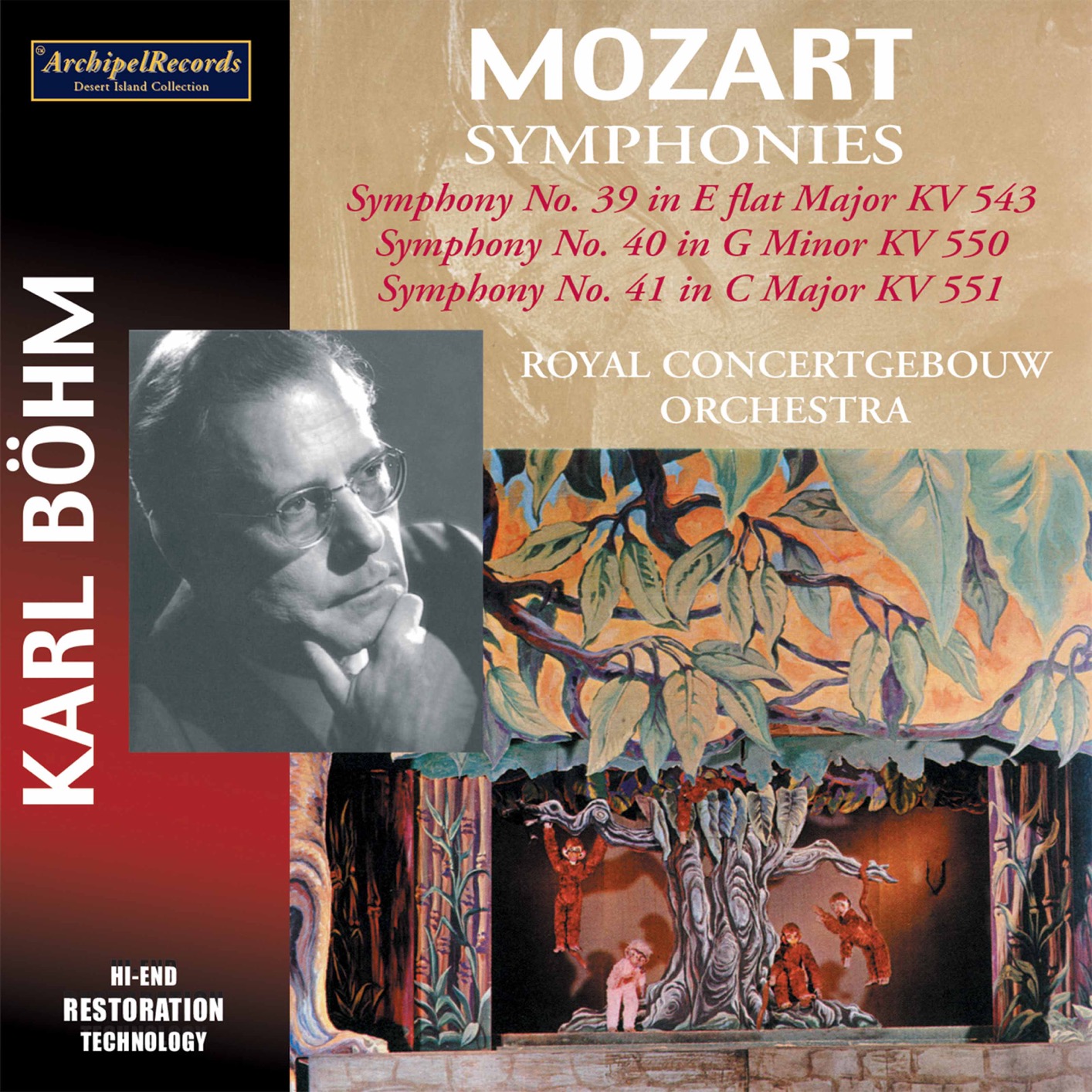
Royal Concertgebouw Orchestra & Karl Böhm – Mozart: Symphonies Nos. 39-41 (Remastered) (2021)
FLAC (tracks) 24 bit/48 kHz | Time – 01:17:06 minutes | 779 MB | Genre: Classical
Studio Masters, Official Digital Download | Digital Booklet, Front Cover | © Archipel
Mozart composed some fifty symphonies, if we include works he adapted from opera overtures or serenades by adding movements or taking them away. The first dates from 1764-5, at the time of his childhood visit to London, and most are early works, quite short. Many are associated with his boyhood travels (his first trip to Italy in 1769-71, for instance) but his most prolific period as a symphonist was between 1771 and 1774 when, in Salzburg, he wrote no fewer than seventeen. A few of these are familiar to modern audiences, in particular those in G minor, K183, and A major, K201, numbered 25 and 29 in the familiar numbering system. After 1781, when he settled in Vienna, he wrote only six more, and the first two of these—the ‘Haffner’ (K385) and ‘Linz’ (K425)—were, as their names imply, designed initially for performance outside Vienna (the Haffner family were friends of the Mozarts in Salzburg). The ‘Prague’ Symphony, though performed in that city, actually had its premiere in Vienna.
In his early years in Vienna Mozart gave many concerts, including some very successful subscription series, so at first sight it seems strange that he did not feel the need to compose new symphonies. The reason for this lack, surely, is that he intended to focus attention on his prowess as a pianist, producing fifteen new concertos for his own use (or occasionally for the use of a gifted pupil) between 1782 and 1786. His concerts did include symphonies, but he relied on those he had composed earlier, as well as introducing the ‘Haffner’ and ‘Linz’ to Vienna. But after several successful years as a freelance musician Mozart began increasingly to suffer from financial problems. The usual reason given for the decline in his fortunes is that the fickle Viennese public grew tired of him once the novelty of his piano playing faded. The truth may be more complex; from 1785 onwards his new works, especially emotionally intense minor-key compositions such as the Piano Quartet in G minor K478, the C minor Piano Concerto K491 and the G minor String Quintet K516, became more demanding, and may have seemed forbidding to ‘polite society’ music lovers. And Mozart may simply have been a victim of economic downturn—an unsuccessful war with the Ottoman Empire starting early in 1788 had a disastrous effect on the Emperor Joseph’s finances.
Mozart’s fortunes reached a low point in June 1788. The Viennese premiere of Don Giovanni had not been the success he hoped for, and he and Constanze were forced to move out of the city to a cheaper, suburban apartment. On June 29 their six-month-old daughter Theresia died, only weeks after Mozart had felt the need to write the first of a long series of begging letters to his friend and fellow-freemason Michael Puchberg. In one of these, dated June 27, he writes of ‘black thoughts’ banished by ‘a tremendous effort’. Yet this period was highly productive. Mozart’s catalogue shows that between June 22 and August 10 he completed his three last symphonies, two piano trios, two sonatas and two or three shorter pieces. The three great symphonies could well have been occupying him during the earlier months of 1788, but Mozart’s ‘tremendous effort’ to counter depression is still extremely impressive. And for what purpose did he write the symphonies? With their contrasting keys and characters, they are clearly designed as a set—did he have publication in mind? Was he preparing himself for a trip to Paris or to London? Or was he once again, as with the six string quartets of 1783-5, emulating Joseph Haydn, whose magnificent ‘Paris’ symphonies (Nos 82-87) had just appeared in print? It is no accident, surely, that the symphonies have the same keys as the first three of Haydn’s set.
The symphonies in E flat, No 39, and C, No 41, both use the full eighteenth-century orchestra, with trumpets and timpani. In No 39 Mozart substitutes clarinets for the usual oboes, and from the brilliantly scored first bar of the slow introduction he begins to exploit the sonorous possibilities of his chosen instrumentation. This introduction is richer and more complex than any that Haydn had so far written, its magnificent progress powered by two rising harmonic sequences separated by a mysterious passage where the prevailing dotted rhythm is reiterated quietly on a static bass note. A rushing downward scale, first heard in the Symphony’s second bar, is an important feature of the introduction and returns in the following Allegro, making a final appearance in the movement’s brilliant coda.
The full orchestral passages in the first and last movements and in the Minuet are characterised by energetic writing for first and second violins in unison, the wind instruments providing unusually full, sonorous harmonic support. But if these passages show Mozart at his most exalted, both the main themes of the first Allegro are intimate and touching. In the third movement too the robust Minuet alternates with a much more delicate, waltz-like Trio. This features the orchestra’s guest artists, the clarinets, who provide both melody and accompaniment.
The Andante begins simply with strings alone; this melody provides virtually all the material of a complex, original movement. A passing shadow, as the theme briefly turns to the minor mode, leads later to a series of remote modulations. These occur during the second of two strenuous episodes; earlier, the first wind entry, stretching out the main theme’s cadence phrase, provides an idea that is developed into a contrapuntal serenade for all the woodwind. The finale shows Mozart taking his cue from Haydn’s brilliantly witty symphonic last movements, allowing the wind to interrupt the violins’ theme and introducing many surprising changes of key in which the theme’s opening motif continually pops up, like an irrepressible cartoon character. In the central part of the movement, however, the ubiquitous motif turns serious, in an almost frenzied display of contrapuntal ingenuity.
Mozart’s final symphony belongs to a sequence of grand ceremonial works in C major (found in Haydn’s output, too) which include several early works as well as the Symphony No 34, K338 (1780), and the ‘Linz’ Symphony (K425). But typically for Mozart, this symphony juxtaposes a number of different musical characters. The martial opening is immediately answered by a yearning motif in the violins which later develops into an intense climbing passage. The second subject, graceful with its chromatic inflexions, is suddenly interrupted by a loud minor-key outburst, and before the end of the exposition yet another character emerges, with a light-hearted phrase that seems to belong to the world of opera buffa. Surprisingly, it is this motif that dominates much of the development section, revealing an unexpectedly earnest, contrapuntal aspect.
The Andante reveals a similarly complex web of contrasting ideas. The formality of the opening phrases leads to a heartfelt, sustained cantilena; an ornamental phrase in the violins, played in answer to a repeat in the bass of the opening phrase, later forms the basis of a magnificent climactic episode. There is also a disturbing, minor key transitional passage with sighing syncopations and extraordinary metrical disruption (for some time the music seems to be in duple time, rather than the triple metre of the movement as a whole). There is a beautiful second theme, bringing the wind instruments into prominence, which Haydn quoted in his Symphony No 98 after hearing of Mozart’s death.
In the Minuet the trumpets and drums, silent in the Andante, enter quietly near the start to re-establish the Symphony’s aristocratic character. It is typical of Mozart that he not only allows the trumpets a prominent fanfare to emphasise the feeling of ceremony but also develops the movement in a different, soulful direction, as a passage for solo woodwind extends and intensifies the chromatic descent of the main theme.
The Jupiter’s finale is the most far-reaching of many instances where Mozart uses contrapuntal techniques to enrich sonata form. On one level the themes have the lively character expected in a symphonic finale; on another they have all been designed to fit with each other in an elaborate range of contrapuntal constructions. The four-note opening motif is a common eighteenth-century formula, used on several previous occasions by Mozart (in the piano and violin sonata K481, for instance). Here it sounds especially familiar, as it has already been heard during the Minuet’s Trio section, as the bass-line at the start of the Andante and, in a disguised, decorated form, in the yearning phrase in the first movement. From a few bars in, when this opening theme gives rise to a five-part fugal exposition, to the coda where five different themes are heard together in a kind of round, Mozart’s compositional virtuosity is on display. And through the whole runs an extraordinary spirit, a mixture of intellectual excitement, the feeling of a grand design, and a sense of fun. The title ‘Jupiter’ may have no authenticity, but the music surely has something godlike about it.
Tracklist:
1. Symphony No. 39 in E flat major, K. 543: Adagio – Allegro (09:04)
2. Symphony No. 39 in E flat major, K. 543: Andante con moto (07:52)
3. Symphony No. 39 in E flat major, K. 543: Minuetto. Allegretto (04:18)
4. Symphony No. 39 in E flat major, K. 543: Finale. Allegro (04:09)
5. Symphony No. 40 in G Minor, K.550: Molto allegro (08:25)
6. Symphony No. 40 in G Minor, K.550: Andante (08:30)
7. Symphony No. 40 in G Minor, K.550: Menuetto. Allegretto (03:32)
8. Symphony No. 40 in G Minor, K.550: Allegro assai (04:58)
9. Symphony No. 41 in C major, K. 551, “Jupiter”: Allegro vivace (08:40)
10. Symphony No. 41 in C major, K. 551, “Jupiter”: Andante cantabile (08:43)
11. Symphony No. 41 in C major, K. 551, “Jupiter”: Menuetto. Allegretto (05:23)
12. Symphony No. 41 in C major, K. 551, “Jupiter”: Molto Allegro (06:13)
Download:
mqs.link_R0yalC0ncertgeb0uw0rchestraKarlBhmM0zartSymph0niesN0s.3941Remastered20212448.rar










![Karl Böhm - Karl Böhm: The SWR Recordings (2023) [FLAC 24bit/48kHz] Karl Böhm - Karl Böhm: The SWR Recordings (2023) [FLAC 24bit/48kHz]](https://imghd.xyz/images/2023/05/24/009d0616.jpg)
![Karl Böhm - Mozart, Beethoven & Others: Orchestral Works (Remastered 2023) (2023) [FLAC 24bit/48kHz] Karl Böhm - Mozart, Beethoven & Others: Orchestral Works (Remastered 2023) (2023) [FLAC 24bit/48kHz]](https://imghd.xyz/images/2023/06/19/ymr5n9xp35tra_600.jpg)
![Karl Bohm, Berliner Philharmoniker - Mozart: Die Zauberflote (1964) [Japan 2016] SACD ISO + FLAC 24bit/96kHz Karl Bohm, Berliner Philharmoniker - Mozart: Die Zauberflote (1964) [Japan 2016] SACD ISO + FLAC 24bit/96kHz](https://getimg.link/images/imgimgimg/uploads/2021/01/I3YCG33.jpg)
![Berliner Philharmoniker & Karl Bohm - Mozart: The Symphonies Vol. I (Remastered) (2018) [FLAC 24bit/192kHz] Berliner Philharmoniker & Karl Bohm - Mozart: The Symphonies Vol. I (Remastered) (2018) [FLAC 24bit/192kHz]](https://getimg.link/images/imgimgimg/uploads/2019/06/ZVk4Yb2.jpg)
![Berliner Philharmoniker & Karl Bohm - Mozart: The Symphonies Vol. II (Remastered) (2018) [FLAC 24bit/192kHz] Berliner Philharmoniker & Karl Bohm - Mozart: The Symphonies Vol. II (Remastered) (2018) [FLAC 24bit/192kHz]](https://getimg.link/images/imgimgimg/uploads/2019/06/e7l6qSw.jpg)
![Berliner Philharmoniker & Karl Bohm - Mozart: The Symphonies Vol. III (Remastered) (2018) [FLAC 24bit/192kHz] Berliner Philharmoniker & Karl Bohm - Mozart: The Symphonies Vol. III (Remastered) (2018) [FLAC 24bit/192kHz]](https://getimg.link/images/imgimgimg/uploads/2019/06/CBMvS46.jpg)
![Karl Bohm - Karl Bohm: The Early Years (2017) [FLAC 24bit/96kHz] Karl Bohm - Karl Bohm: The Early Years (2017) [FLAC 24bit/96kHz]](https://getimg.link/images/imgimgimg/uploads/2019/06/5Wtfzge.jpg)
![Berliner Philharmoniker & Karl Bohm - Mozart: The Symphonies Vol. IV (Remastered) (2018) [FLAC 24bit/192kHz] Berliner Philharmoniker & Karl Bohm - Mozart: The Symphonies Vol. IV (Remastered) (2018) [FLAC 24bit/192kHz]](https://getimg.link/images/imgimgimg/uploads/2019/06/61rqgO5.jpg)
![Karl Bohm - Wagner - Tristan und Isolde, WWV 90 (1966/2017/2021) [FLAC 24bit/96kHz] Karl Bohm - Wagner - Tristan und Isolde, WWV 90 (1966/2017/2021) [FLAC 24bit/96kHz]](https://mqs.link/wp-content/uploads/2022/04/YHqYVL8-1.jpg)
![Staatskapelle Dresden, Karl Böhm - R. Strauss: Eine Alpensinfonie, Op. 64, TrV 233 (2022) [FLAC 24bit/96kHz] Staatskapelle Dresden, Karl Böhm - R. Strauss: Eine Alpensinfonie, Op. 64, TrV 233 (2022) [FLAC 24bit/96kHz]](https://i0.wp.com/imghd.xyz/images/2022/03/05/d4wl0p9wnrrjc_600.jpg?resize=500%2C500&ssl=1)
![Wiener Philharmonic Orchestra, Karl Bohm - Beethoven: Symphony No.6 “Pastoral” - Schubert: Symphony No.5 (2015/2021) [FLAC 24bit/96kHz] Wiener Philharmonic Orchestra, Karl Bohm - Beethoven: Symphony No.6 “Pastoral” - Schubert: Symphony No.5 (2015/2021) [FLAC 24bit/96kHz]](https://mqs.link/wp-content/uploads/2022/05/YDGiLeP.jpg)
![Karl Bohm, Berlin Philharmonic Orchestra - Schubert: Symphony No. 5; Mozart: Symphony No. 33 (1966/2015) [FLAC 24bit/352,8kHz] Karl Bohm, Berlin Philharmonic Orchestra - Schubert: Symphony No. 5; Mozart: Symphony No. 33 (1966/2015) [FLAC 24bit/352,8kHz]](https://getimg.link/images/imgimgimg/uploads/2019/07/z4mRmj4.jpg)